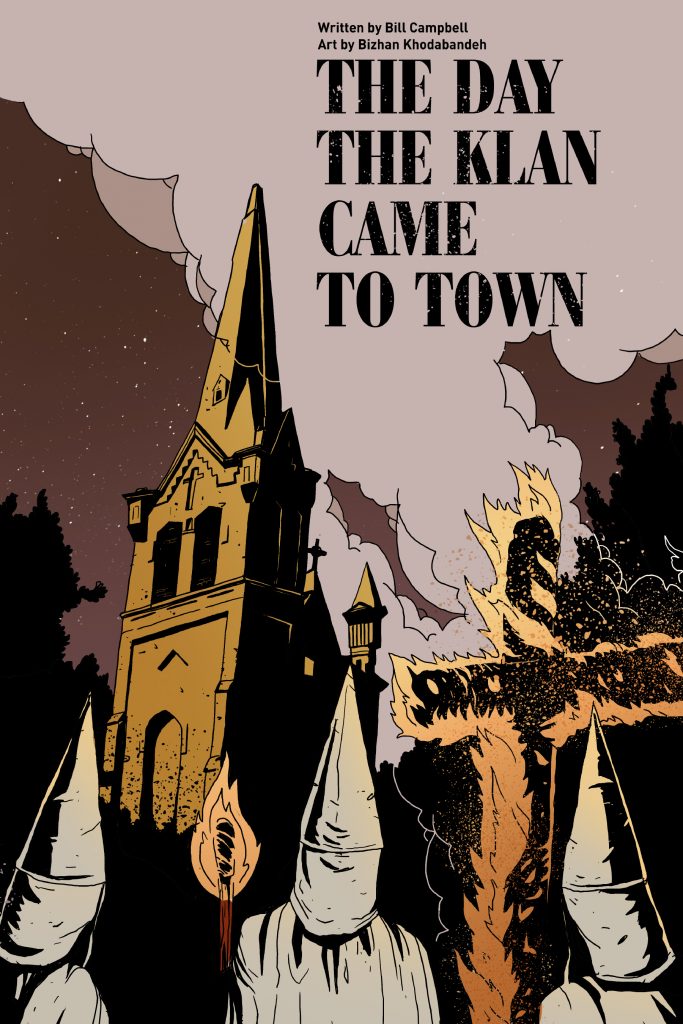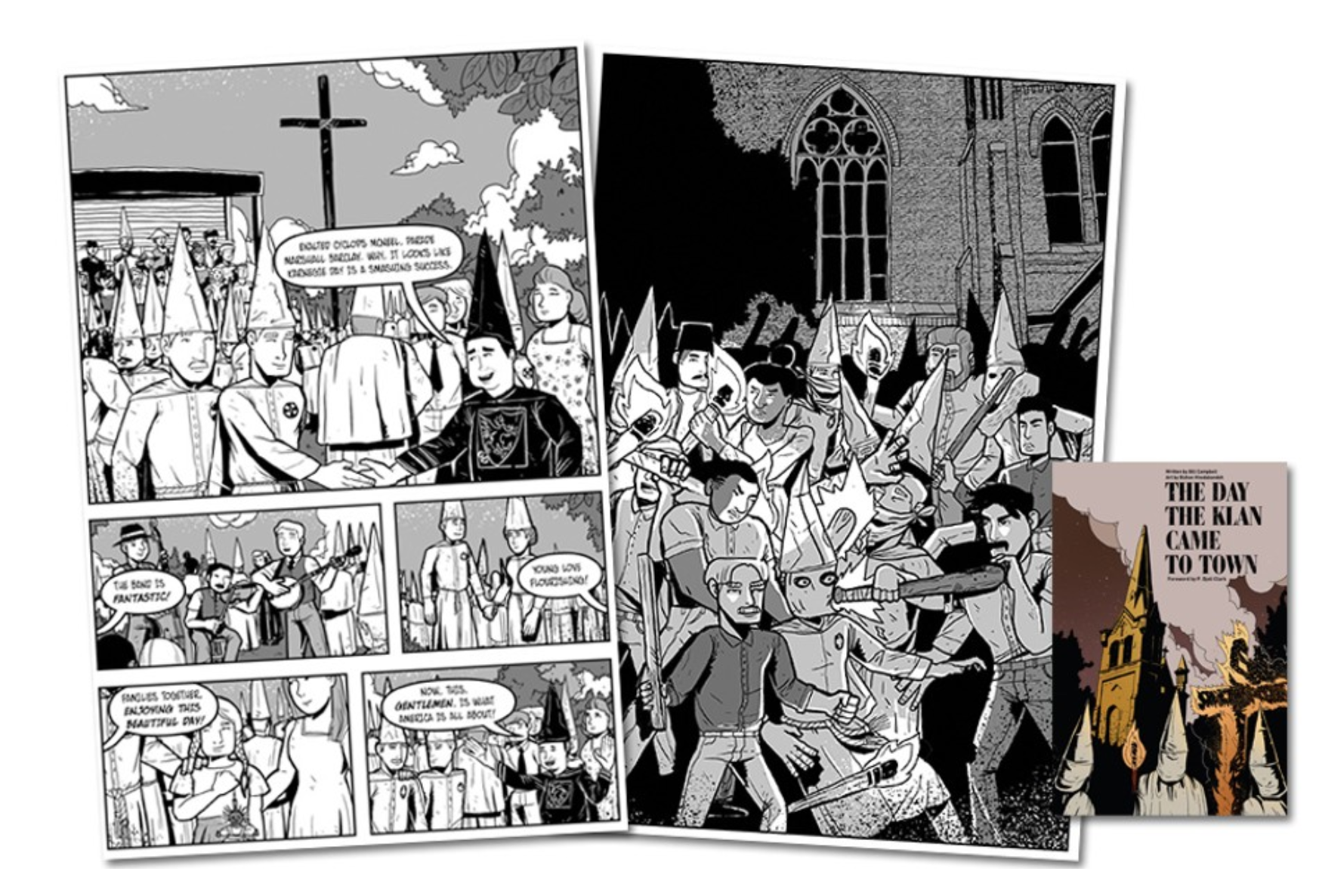By Rich Griset
Style Weekly
March 23, 2021
Local artist highlights little-known KKK riot in new graphic novel.

“The Day the Klan Came to Town,” a graphic novel written by Bill Campbell and illustrated by local artist Bizhan Khodabandeh.
Though you’ll find little written about it in the history books, on the evening of Aug. 25, 1923, the Ku Klux Klan met its match in Carnegie, Pennsylvania.
In this Allegheny County borough southwest of Pittsburgh, the Klan organized a large demonstration and initiation ceremony called “Karnegie Day.” The fact that Carnegie had a sizeable Catholic population was part of its appeal to the Protestant KKK, which was on the verge of attracting 5 million followers – the peak of the Klan’s second wave – in 1925. When an estimated 10,000 to 30,000 Klansmen invaded Carnegie, the town took to the streets. By the end of the violent conflict, one Klansmen had been shot to death and hundreds injured.
In his scholarly article “‘There Is Hell Going on up There’: the Carnegie Klan Riot of 1923,” historian John M. Craig explains that while the KKK tried to position itself in the South as a legitimate political interest group that advanced philanthropic causes, in the North and Midwest it turned to violence to increase its numbers. Pennsylvania Grand Dragon Samuel Rich said “it takes riots to swell the ranks of the Ku Klux Klan.”
The KKK often held parades, picnics and cross burnings in areas with large numbers of Catholics in hope of becoming violent. “In the Carnegie disorder, as in many other instances, Klansmen aroused hatred, sought conflict and came armed with weapons,” Craig writes.
Carnegie’s homegrown repelling of the KKK is the subject of “The Day the Klan Came to Town,” a forthcoming graphic novel written by Rosarium Publishing’s Bill Campbell and illustrated by local artist Bizhan Khodabandeh. Published by PM Press in Oakland, California, the graphic novel dramatizes the conflict from the viewpoint of a group of immigrants.
Campbell, a native of Carnegie who now lives near Washington, first learned of the riot as an adult through a conversation with his brother. Driving around Carnegie, he came up with the idea of Primo, the Italian protagonist of the graphic novel.
At the time of the riot, Pennsylvania had seen an influx of predominantly Catholic immigrants to work in steel mills, coal mines and on the railroads. As Khodabandeh notes, many of these ethnic groups, such as those from Southern and Eastern Europe, weren’t considered white by American society at that time. Often, they fled their native countries because of violence and harassment.
“[They’re] escaping fascism in their own country, and then they’re confronted by this again in the United States,” explains Khodabandeh, winner of a silver medal for comics and cartooning from the Society of Illustrators.
The theme of immigrants being subjected to violence runs throughout the graphic novel, with each chapter break referencing a different atrocity that took place in America, such as the lynching of a German immigrant and the burning of shrimp boats operated by Vietnamese immigrants in Texas.
Though the project was underway before the Jan. 6 storming of the U.S. Capitol by supporters of former President Donald Trump, both Khodabandeh and Campbell see parallels in the graphic novel. In creating the book, Khodabandeh says that the plight of immigrants under the Trump administration was at the forefront of their minds.
“Many of the participants of this past uprising [were] wearing anti-Semitic rhetoric, even neo-Nazi and fascist symbols and garb,” Khodabandeh says. “History does seem to repeat itself.”
The graphic novel’s creators have their own immigrant stories. Campbell’s father is a Jamaican immigrant and Khodabandeh’s father emigrated from Iran in the 1970s. Attending Glenville State College in West Virginia, Khodabandeh’s father ran into his own discrimination and harassment when the Iran hostage crisis began in 1979.
“He quickly went from being the weird foreign kid … to being the enemy,” Khodabandeh says. “He had been in some physical altercations with some of the students and treated poorly by some of the professors.”
In one notable incident, a fellow Iranian immigrant ran to Khodabandeh’s father’s house while being chased by a group of fraternity members and football players. Khodabandeh’s father was a wrestler and ended the altercation by body slamming one of the football players. Khodabandeh later retold this story in graphic form for “New Frontiers: the Many Worlds of George Takei,” an anthology inspired by the life and legacy of the actor best known for playing Hikaru Sulu on “Star Trek.” Khodabandeh’s father eventually transferred to Howard University to escape the abuse.
Currently in editing, “The Day the Klan Came to Town” should be published by August and can be purchased through the comic’s Kickstarter or preordered online through PM Press. Khodabandeh also recently released “Welcome to Bizhanistan,” a collection of his abstract comics.
With the pandemic reducing his illustration and graphic design client work, Khodabandeh, who’s also employed as an instructor at Virginia Commonwealth University, decided to devote more time to the project.
“It felt very meditative. It was a nice breath of fresh air,” he says of the abstract work. “I don’t have to worry about portions or perspective, and when I mess something up, I just draw something on top of it.”
“The Day the Klan Came to Town,” can be purchased at pmpress.org. “Welcome to Bizhanistan” can be purchased at Velocity Comics and Rumors or by messaging the artist on Instagram.
Back to Bizhan Khodabandeh’s Author Page







